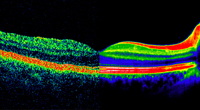October 27, 2008
 |
| Eye scan images without (left) and with (right) OCT. |
BIRMINGHAM, Ala. - New technology at UAB (University of Alabama at Birmingham) will lead to quicker diagnosis of eye conditions such as glaucoma or retinal disease.
The glaucoma service in the Department of Ophthalmology has obtained the most sophisticated package of imaging tools available to ophthalmologists, featuring three state-of-the-art imaging machines that provide more detailed images of the eye. The machines also will help physicians monitor the progression of disease over time. In addition, the service is developing research into adaptive optics techniques which will bring ocular imaging to the cellular level.
"These machines will allow for better, quicker diagnosis of glaucoma and other eye diseases," said Christopher Girkin, M.D., professor of ophthalmology and director of the UAB glaucoma service. "They will provide better follow up and give us a much better picture of how quickly the disease is progressing in the eye."
The three new machines are spectral domain optical coherence tomography machines (OCT), providing more complete and detailed images of the eye than was previously possible at a histologic, or tissue, level.
The newest weapon in UAB's arsenal is the Spectralis by Heidelberg Engineering of Germany, which combines a confocal scanning laser ophthalmoscope with the fastest spectral domain OCT available. It scans the retina at 40,000 scans per second, creating highly detailed images of the structure of the retina, about 100 times faster than previous machines.
The Cirrus HD-OCT, manufactured by Zeiss Meditec, provides high resolution images of the back of the eye in three dimensions.
The third machine is a spectral domain OCT machine manufactured by Optoview, the RTVue-100. It has similar resolution capabilities but has software that can map layers of the retina. All machines will be used in clinical and research applications.
Each machine costs about $100,000, but UAB has received them at no cost. The manufacturers have provided the machines to a few leading research centers such as UAB to provide baseline data for high risk patients and to establish parameters for general use. The UAB glaucoma service has been engaged in this research over the past year and is the only program in the region that provides a comprehensive multimodal imaging service.
The Department of Ophthalmology recently recruited a pioneer in the field of ocular imaging, Dr, Yuhua Zhang, Ph.D., who will establish an adaptive optics program. Adaptive optics was first created to help high-powered telescopes see clearly through layers of interference in deep space. The technology has been turned inward, and adaptive optics allows microscopes and other imaging systems to compensate for aberrations on the cornea and lens of a patient. This leap in technology will provide the ability to visualize living cells within the human eye.